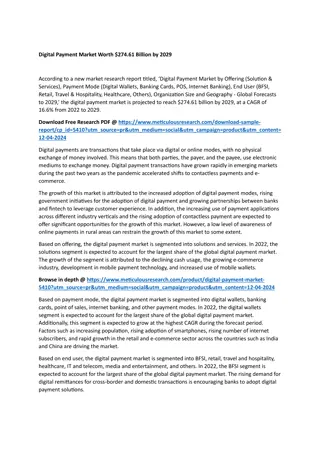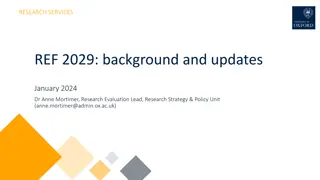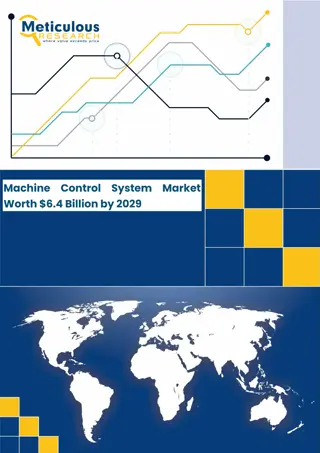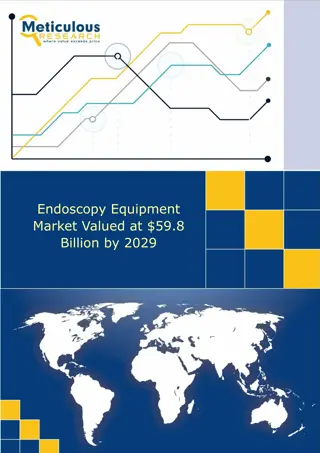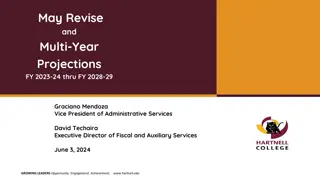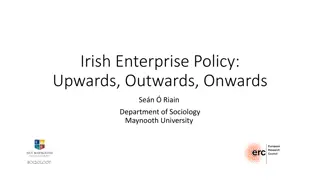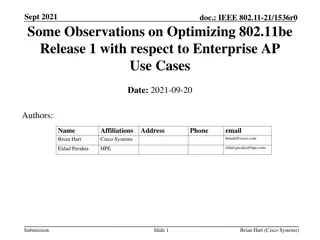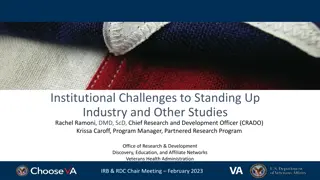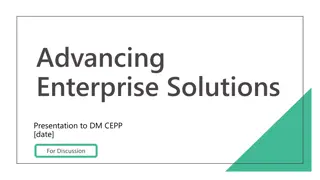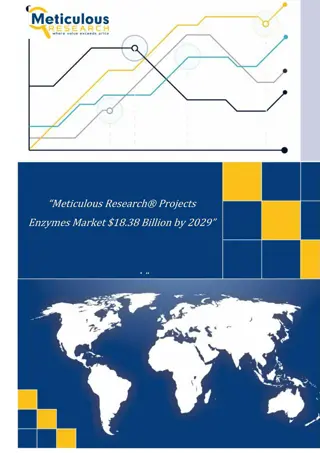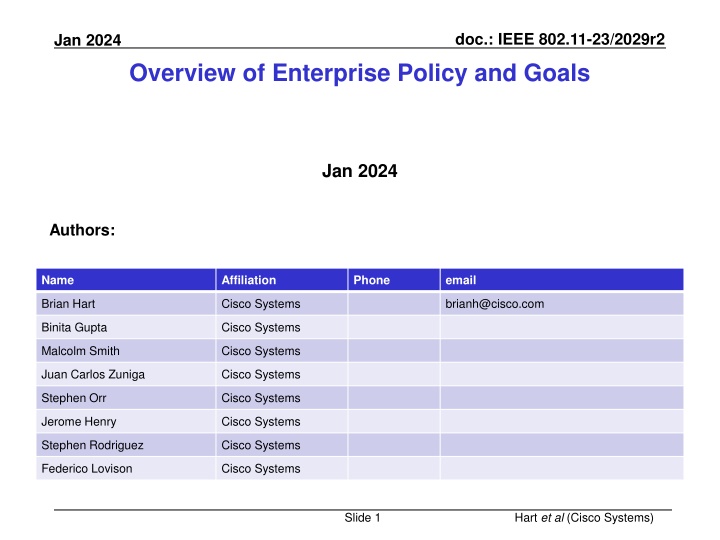
Overview of Enterprise Network Policies and Goals in IEEE 802.11-23/2029r2
This presentation discusses the enterprise network policies and goals within the IEEE 802.11-23/2029r2 framework. It covers concerns regarding AP treatment of STAs, enterprise use cases in various settings, and the myth vs. reality of singling out STAs for special treatment. Additionally, it highlights the evolution of enterprise features over the past two decades and the collaboration between infrastructure and client vendors to enhance user experience.
Download Presentation

Please find below an Image/Link to download the presentation.
The content on the website is provided AS IS for your information and personal use only. It may not be sold, licensed, or shared on other websites without obtaining consent from the author. If you encounter any issues during the download, it is possible that the publisher has removed the file from their server.
You are allowed to download the files provided on this website for personal or commercial use, subject to the condition that they are used lawfully. All files are the property of their respective owners.
The content on the website is provided AS IS for your information and personal use only. It may not be sold, licensed, or shared on other websites without obtaining consent from the author.
E N D
Presentation Transcript
doc.: IEEE 802.11-23/2029r2 Jan 2024 Overview of Enterprise Policy and Goals Jan 2024 Authors: Name Affiliation Phone email Brian Hart Cisco Systems brianh@cisco.com Binita Gupta Cisco Systems Malcolm Smith Cisco Systems Juan Carlos Zuniga Cisco Systems Stephen Orr Cisco Systems Jerome Henry Cisco Systems Stephen Rodriguez Cisco Systems Federico Lovison Cisco Systems Slide 1 Hart et al (Cisco Systems)
doc.: IEEE 802.11-23/2029r2 Jan 2024 Motivation During 802.11be development, concerns were raised that a new feature might allow an AP to treat a STA differently Yet, if the STA had different credentials and was associated to a different SSID with that feature, then the concerns disappeared The purpose of this presentation is to identify how these 802.11be-era concerns are misplaced and to define the goals of enterprise networks Slide 2 Hart et al (Cisco Systems)
doc.: IEEE 802.11-23/2029r2 Jan 2024 Flow Policy - Sample Enterprise Use Cases In a hospital, there are: Critical systems for supporting and monitoring patient health Vital systems for clinician communications Important systems for guest connectivity (patients and family) In a stadium, there are: Biz-critical systems for back-of- house operations (e.g., patron ticket validation, revenue generation) Vital systems for event-related crowd communications (e.g., replay stream) Important systems for patron connectivity In a hotel, there are: Critical systems for security (e.g., wireless hotel room door locks, housekeeper panic buttons) Vital systems for guest connectivity In a factory, there are: Critical systems for person-down alerts Biz-critical systems for real-time automated manufacturing Important systems for non-real-time monitoring and other communications Slide 3 Hart et al (Cisco Systems)
doc.: IEEE 802.11-23/2029r2 Jan 2024 Myth: STAs should not be able to be singled out for special treatment Reality: The previous use cases (and many others) have been addressed by a variety of enterprise features over the past two decades STAs are already singled out for special treatment and for good reason; and those good reasons won t go away Meanwhile, some infrastructure vendors work with some client vendors to provide forward-looking features and a better experience in this environment; then later bring such features to 802.11 as part of a virtuous circle. In fact, such standard-track features allow the wider community to catch up and help each other. Slide 4 Hart et al (Cisco Systems)
doc.: IEEE 802.11-23/2029r2 Jan 2024 Enterprise Policy In a typical enterprise, the wireless link is one part of the network Enterprise policy needs to be applied at the network level, and applies to every portion of the network (wireless, switching & routing, SD-WAN, public cloud, etc) 1. Security policy 2. Flow policy Slide 5 Hart et al (Cisco Systems)
doc.: IEEE 802.11-23/2029r2 Jan 2024 Security Policy is applied Enterprises are under continual attack by: Nation-state actors (e.g., industrial espionage) Hacking groups (e.g., ransomware) etc As an example, for many enterprises, guest traffic must be tunneled directly from AP to a Wireless LAN Controller in the DMZ; so such traffic is entirely segregated from the intranet traffic Given the prowess of the attackers and the costs of a successful attack, modern zero-trust architectures limit device access to only the required portions of the enterprise network, then continually profile devices for policy deviations to detect when and if they become compromised (i.e., trust-based access) The Secure Group Tag (SGT) is a vital mechanism to indicate the privileges of the source within the network; another segregation tool is VLANs For instance, one SGT/VLAN may be allocated to provide devices with the minimal access needed for remediation Slide 6 Hart et al (Cisco Systems)
doc.: IEEE 802.11-23/2029r2 Jan 2024 The Traditional Solution In the early days of 802.11, both security and flow policy were applied via different SSIDs: Mapped to different VLANs and with different security parameters with different EDCA parameters (or with limited access to ACs) This remains a popular segmentation mechanism, but quickly becomes inadequate and inefficient: Switches typically support ~4K VLANs (802.1Q) & there are 64K SGTs, although practically we typically see more like 10-100 micro-segments (aka virtual networks) in use Yet enabling more than a few SSIDs leads to undesirable wireless inefficiency Multiple SSIDs produce multiple beacons and probe responses (especially at 2.4/5 GHz) so SSID proliferation is not best practice For instance, Wi-Fi Passpoint uses one SSID for all clients The achievable QoS with this technique does not position us well for modern application flows like AR/VR or automated manufacturing Slide 7 Hart et al (Cisco Systems)
doc.: IEEE 802.11-23/2029r2 Jan 2024 Flow Policy - How Everything is Supposed to Work When the pipes are fat enough, the goal of the enterprise network is to deliver all traffic in a timely manner; and when the pipes are congested, the end-to-end service level agreement (E2ESLA) of biz-critical flows must be maintained as the first priority; then other flows after that. Components of the solution Endpoints categorize their traffic in accordance with enterprise app& user priority NOTE - Different apps are biz-critical in different settings (gaming in automated manufacturing vs dorm rooms) and mark & map it following enterprise policies on DSCP selection & DSCP to UP mapping NOTE - The treatment of any given DSCP is locally defined, guided by IETF RFC/ vendor recommendations/ local configuration. It is important to align DSCP of flows with configuration of router buffers (see example in backup); that is, proper DSCP marking is dependent on the local network policies. Endpoints report the QoS Char. of QoS flows (IP tuple), so the enterprise network can perform: Correct wireless scheduling and E2E reservations (for all chokepoints including wireless and SD-WAN) All endpoints on a shared medium (e.g., wireless) enable/respect all flows by enterprise priority: E.g., Support (and not disable) triggered access and respond with queued traffic according to enterprise policy (perhaps with new requirements on UORA(++) as a better safety valve than UL MU Disable) Flow-aware (QoS-aware) Multi-AP Coordination E.g., C-R-TWT; or sharing TXOPs via C-TDMA/C-SR with nearby APs that have more critical & impending traffic, etc e.g., WFA QoS Mgmt DSCP Policy & QoS Mapping and/or SCS DSCP+UP counter- proposal Slide 8 Hart et al (Cisco Systems)
doc.: IEEE 802.11-23/2029r2 Jan 2024 What Happens When Not Everything Works That Way? Answer: Endpoints without Biz-critical traffic suffer Potential wireless problems Endpoints don t follow enterprise policy for treatment of flows: app priority too high/low or not sensitive to user, don t mark DSCP correctly, or improperly map DSCP to UP Not all endpoints support triggered access / don t respect R-TWT SPs Then enterprise has to separate biz-critical flows from other flows, at some level If the enterprise cannot separate a device s flow (fine-grained), then it has separate the device (coarse-grained) and/or the device s AC(s) (medium-grained) Approaches are limited by feature support of most all devices on the channel; so need to raise that support level Separation via: Orthogonal in frequency - channel separation (coarse-grained, strongest) EHT upgrades this: can add other endpoints to the dedicated channel if and while it is lightly loaded; but it takes ~10 sec to move endpoints to/from the dedicated channel so first there needs to be a clear sustained opportunity; during ephemeral opportunities, endpoints are still squeezed into the other channels Other endpoints are squeezed into the AP device s other channels. Broad respect for R-TWT would allow a channel with biz-critical flows to be safely shared with other endpoints; but EHT, optional; so triggered access is better positioned Limit maximum AC available to devices without biz-critical role (medium-grained, weaker) Since separation is device level not flow level, QoS traffic on devices that can never have high priority flows is disadvantaged wrt QoS traffic on devices that could have high priority flows. Orthogonal in time - triggered access / R-TWT (fine-grained, strong) Endpoints that don t support & enable these features are squeezed into the AP device s other channels. Slide 9 Hart et al (Cisco Systems)
doc.: IEEE 802.11-23/2029r2 Jan 2024 Summary Endpoints are subject to enterprise policy, and this will continue No one is proposing 50/100/4K/64K SSIDs per AP, so almost surely there will be: A single converged SSID or a very small number of semi-converged SSIDs Endpoints in the same SSID are liable to be treated differently, from: a security perspective (different SGTs/VLANs), and a flow policy perspective; and thence the capabilities of the endpoint The availability of widely supported and granular channel access tools maximizes the enterprise network s ability: to assure biz-critical flows meet their QoS requirements with the least collateral damage = every channel and every TXOP that is not specifically needed for biz-critical flows is available to every other endpoint Granular tools for assuring E2E QoS (with new work): WFA QoS Mgmt DSCP Policy and QoS Mapping and/or SCS DSCP+UP counterproposal (enabled by MDM / agent if applicable) SCS with QoS Characteristics element with TCLAS-level UL&DL granularity Supported, enabled triggered access; endpoints respond with queued traffic according to enterprise policy: beyond Preferred AC (e.g., informed by DSCP Policy & QoS Mapping) + better safety valve than UL MU Disable (perhaps new requirements on UORA[++]) Flow-aware (QoS-aware) Multi-AP Coordination (e.g., C-R-TWT; or sharing TXOPs via C- TDMA/C-SR with nearby APs that have more critical & impending traffic, etc) Per flow not per TID, per AC or per device; & Per TXOP not per channel Slide 10 Hart et al (Cisco Systems)
doc.: IEEE 802.11-23/2029r2 Jan 2024 Strawpoll Do you support a mode of operation where wireless medium resources are efficiently used to meet the QoS requirements of certain entities (defined as a function of user, application, flow, device type, STA's capabilities, etc) Y / N / A Slide 11 Hart et al (Cisco Systems)
doc.: IEEE 802.11-23/2029r2 Jan 2024 Backup Slide 12 Hart et al (Cisco Systems)
doc.: IEEE 802.11-23/2029r2 Jan 2024 Flow Policy The Basics When the pipes are fat enough, the goal of the enterprise network is to deliver all traffic in a timely manner; and when the pipes are congested, the end-to-end service level agreement (E2ESLA) of biz-critical flows must be maintained as the first priority; then other flows after that. This goal is achieved via: App & user policy: which apps by which users are biz-critical / not App flow requirements: loss rate, latency, jitter, min data rate Control mechanisms: queuing / scheduling / coordination For example, if an enterprise determines that the voice flow in a collaboration app by an employee is biz-critical, then: This class of flows is assigned a DSCP value (often 0xEF (46) but not necessarily) and The employee s endpoint should use DSCP = 0xEF for that flow; else the network ingress should re-mark packets to that DSCP via App Visibility (DPI) & Control (re-marking) Routers are configured accordingly (e.g., queue for the DSCP = 0xEF is shallow with short buffers, and the DSCP queue gets proportionally more transmit opportunities than other queues (CBWFQ*) Assigning the wrong DSCP value could put FTP packets in a queue with only short buffers, or voice packets in the same queue as FTP packets Important at chokepoints (SD-WAN and wireless) At switches (and APs) the DSCP 0xEF value is mapped, according to the local enterprise QoS map, to a suitable 802.1p priority (e.g., 6), and at L2 the DSCP s UP queue gets proportionally more transmit opportunities than other queues * CBWFQ = Class-Based Weighted Fair Queuing ~ EDCA Slide 13 Hart et al (Cisco Systems)
doc.: IEEE 802.11-23/2029r2 Jan 2024 When the Network Needs to Step In (High-Level) Endpoint2 has biz-critical traffic (but either under-marks it or other endpoints aren t respecting flows by priority). Endpoint3 does not have biz- critical traffic (but might over- mark what it has, or doesn t respect flows by priority) Endpoint1 supports all the solution components Network must reserve resources for endpoint2, at the minimum resource granularity defined & supported by endpoints; coarser granularity means greater rounding up of the resources dedicated to endpoint2. Network must protect biz- critical flows from endpoint3, at the minimum resource granularity defined & supported by endpoints; coarser granularity means greater rounding up of the resources denied to endpoint3. If all other devices are equally capable, all devices and flows get the same SLA-aware scheduled experience. Natural resource allocation Rounded-up resource allocation How do we reduce this collateral damage on well-behaved devices? How do we reduce this collateral damage on under-behaving devices? Slide 14 Hart et al (Cisco Systems)
doc.: IEEE 802.11-23/2029r2 Jan 2024 When the network needs to apply actual (or potential) policies, collateral damage is caused, which we strive to minimize Approach Feature With collateral damage Different SSID by device type, and devices without biz-critical traffic don t get access to the higher AC(s) (and their DSCPs are re- marked) (Metal Policy) Multiple SSIDs & EDCA params Since control is device level not flow level, QoS traffic on devices that can never have high priority flows is disadvantaged wrt QoS traffic on devices that could have high priority flows. Multiple SSIDs Other endpoints are squeezed into the AP device s other channels. Dedicate an AP device s channel to endpoints with a biz-critical purpose Dedicate a channel to endpoints currently carrying biz-critical traffic BLB TTLM mode 1^ Endpoints without that traffic are squeezed into the other channels. As an upgrade, can add other endpoints to the dedicated channel if and while it is lightly loaded; but it takes ~10 sec to move endpoints to/from the dedicated channel so first there needs to be a clear sustained opportunity; during ephemeral opportunities endpoints are still squeezed into the other channels Dedicate a channel to TIDs of endpoints currently carrying biz-critical traffic, plus other TIDs/endpoints if and while the channel is lightly loaded 11be TTLM mode 3 Since it takes ~10 sec to move endpoints to/from the dedicated channel so first there needs to be a clear sustained opportunity; during ephemeral opportunities endpoints are still squeezed into the other channels LLB*, BLB^ Channel for endpoints that implement 11ax and that are not asserting UL MU Disable LLB*, BLB^ support and enable the DSCP Policy + QoS Map features of Wi-Fi certified QoS Management (or equivalent) Endpoints that don t support the corresponding feature are squeezed into the AP device s other channels. support R-TWT LLB*, BLB^ LLB*, BLB^ support UORA partner-partner proprietary features *LLB: Legacy Load Balancing (probe suppression, association rejection, BSS Transition Management); ^BLB: Basic Load Balancing (BTM + TTLM) Slide 15 Hart et al (Cisco Systems)




